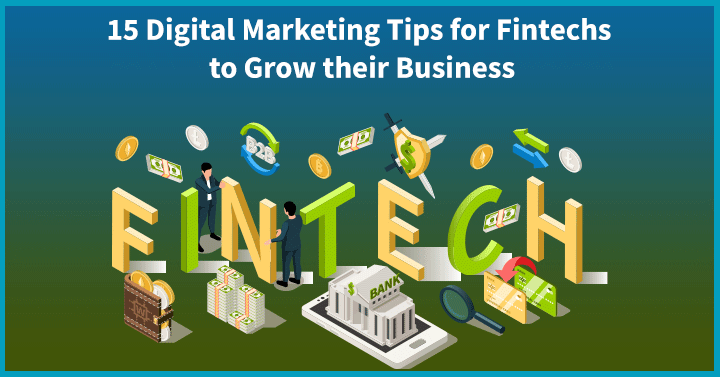Want to catalyze your fintech’s growth? Whether your business is longstanding or just getting started, our digital marketing tips will help you attract, engage and delight your customers. Digital marketing for fintech is built on the same fundamentals of other industry marketing. It is not about how you market but where the customer wants to be marketed.
With over 162 startups valued at over $1 billion, fintech is one of the fastest-growing industries. In addition to startups, many established fintech firms have started catching up with digital technologies and become a part of the growing fintech ecosystem. As a result, the fintech sector is becoming increasingly competitive.
Today, companies face numerous challenges such as increasing regulations, low budget, lack of trust and credibility, data privacy risks, etc., that affect the success of their marketing efforts. Nevertheless, a few companies have managed to cut through the noise and are leading the way, taking some bold approaches in digital marketing for fintech.
This post will dive into the most effective approaches to digital marketing for fintech that can position them for significant profitability and immense growth.
What is Fintech Marketing?
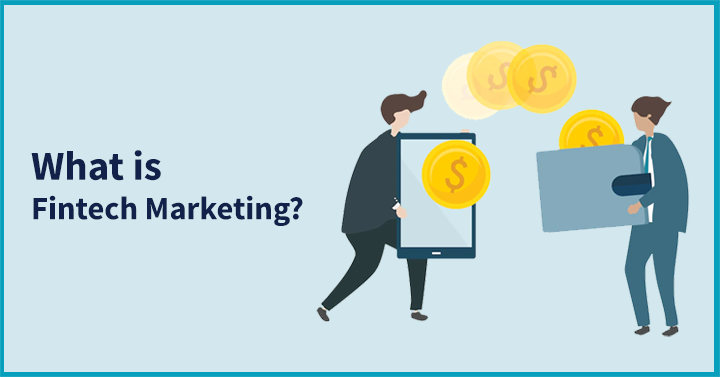
Fintech marketing comprises tactics and tools used by financial technology firms to drive business growth. It is a highly specialized field of advertising and promoting financial technology.
With financial technology continuing to grow in several areas in the financial sector, marketing tactics to meet the evolving needs of consumers are rapidly changing.
According to sources, 24% of consumers use a fintech banking platform. To capitalize on the potential of digital marketing for fintech, companies must embrace how consumer behavior is shaping the market. The key is to focus on digital marketing tactics tailored to unique products, services, and expectations.
10 Fintech Marketing Strategies for Business Growth
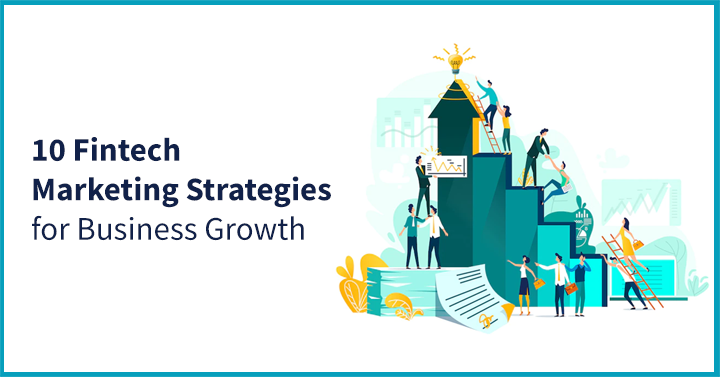
1. Adopt a Mobile-First Strategy
The use of smart devices has revolutionized the fintech industry. With 75% of search traffic coming from mobile devices, more and more companies prioritize their mobile experiences and reshape how they interact with their end-users and maximize the benefits of digital marketing for fintech.
According to sources, mobile banking via smartphones was the most preferred method of interaction with fintech firms. If the financial institution fails to fulfill the needs of those who prefer mobile channels, they are more likely to be left with fewer consumers. To get the most out of the digital marketing for fintech, one should target mobile users by ensuring they have a mobile responsive website.
Embracing a mobile-first mindset helps you develop relationships with the target audience and ranks higher in Google search results. In addition, you can create a seamless mobile-based user experience to convert consumers in 2022 and beyond by removing unnecessary widgets, irrelevant content, and pop-ups.
2. Leverage the Power of Social Media
When it comes to digital marketing for fintech, social media is the best place where you get to target your ideal customers. So whether it is Twitter, Facebook, Linkedin, Snapchat, Pinterest, Digg, Tumblr, or YouTube – you need to pick the right channel to share your message and adopt the right marketing strategy for fintech.
Create personalized content on a platform where your audience hangs out and adopt a strategy for reach. Many are leveraging social media to monitor and increase customer satisfaction, from long-established fintech firms like Revolut to startups such as SolarisBank and Flinks.
For instance, American Express leveraged the power of social media by allowing its customers to link Facebook or FourSquare accounts with their Amex cards. The company engaged its customers by offering deals from data drawn from their accounts.
3. Use Storytelling in Content Marketing
Storytelling is a powerful way for fintech companies to strengthen their brand. Through personal stories, they can target their audience on a journey they yearn to experience or discover. In addition, fintech companies can bring their work to life through humorous and realistic content that connects with their audience’s emotions.
Millennials are often confused about the financial situations surrounding them. A recent study found that 45% of millennials look for products and services that help them manage their finances. Creating valuable content for millennials is the key to positioning your fintech company on top. You will build a brand reputation and bring in more business with valuable content.
For example – Penn Mutual, one of the leading life insurance companies in the USA, used short narrative videos to educate the importance of life insurance for their prospects. In addition, they used storytelling campaigns to strengthen their brand in the life insurance sector.
4. Develop a Unique Branding Strategy
When it comes to developing customer connections, fintech companies must adopt a customer-centric approach to every aspect of the marketing funnel to leverage the maximum out of practices in digital marketing for fintech. It can be challenging for those operating at the B2B level to create opportunities for customers to experience their brand physically.
One should align their branding strategy with the needs of their target audience. For instance, you should go bold with branding if you target millennials. However, avoid the slip of ‘nothingness’ with the powerful message you want to portray. Decide on your branding strategy early to ensure everything is consistent throughout the B2B fintech marketing campaigns.
Besides, fintech firms should provide customers with guidance, advice, and education, not just information on using their products. Finally, by holding contests, creating puzzles, and awarding prizes – fintech brands can generate customer interest.
Let’s take a look at fintech firms with a unique branding strategy.
Starling Bank is the best example of a fintech firm with a unique branding strategy. They have an awesome newsletter named ‘Murmun’ with diverse content. To meet their content marketing goals, they publish engaging and relevant blogs. The user-generated content comprises success stories of those who achieved success with their app. If you want to improve your marketing strategy, signup for Starling’s newsletter and understand why it is successful.
Robinhood is another example of a fintech firm with a unique branding strategy. Their concept of “democratizing stock market investing” is seen throughout their branding strategy. When it comes to branding, what stands out is their 15-minute podcast and 3-minute newsletter. The company marketed these mediums as “Robinhood Snacks,” which people can consume during morning walks or commuting to the office.
5. Invest in Advertising Campaigns
Digital marketing for fintech is about making an impact on the target audience. Therefore, fintech firms should optimize their ad campaigns for specific niche targeting to create the most of their marketing efforts.
With a growing need to attract a diverse audience, fintech firms can publish creative ads on Facebook, Instagram, Google, LinkedIn, and other channels. However, it is advised to target the right audience with appropriate keywords, interests, demographics, and call-to-actions.
Some of the best fintech advertising campaigns in recent years include – cashless on the catwalk by Visa Europe Collab, Unfreeze your money by WePay, and Simplicity is the ultimate sophistication by Nutmeg.
6. Collaborate With Influencers and Affiliates
When it comes to financing, people often take the advice of their family, friends, and role models. In the same way, influencers and affiliates can be your best buddy in digital marketing for fintech. Yet, only a few financial companies tap into the potential of using social media influencers to promote their products and services.
With countless influencers on Instagram, YouTube, Twitter, and Facebook, influencer marketing is an excellent strategy in innovative digital marketing for fintech to instantly create awareness of the product and services. Select the influencers carefully to make the most out of influence marketing.
You don’t have to go after big names in the influencer space. There’s a group of influencers with 100 to 100,000 followers called micro-influencers. Although they have fewer followers, they are incredibly more engaged. In short, influencers are great for fintech business.
For example, the Swedish company Klarna International adopted influencer marketing in its style. They recruited Snoop Dogg to be the face of their Get Smooth advertisements. Klarna rebranded with a marketing campaign with random items like cheese, fish, swimming dog, etc. The ad campaign that features Snoop Dog attracted barely 18,000 followers.
When approaching influencers to market your brand, it is crucial to find someone who understands your vision. Influencer marketing is a vital strategy, especially if you want to target millennials and Gen Z. It allows fintech brands to convey the message uniquely.
7. Use In-App Display Marketing
Fintech in-app marketing refers to any marketing campaign developed and deployed within the mobile application. It is designed to be displayed to your target audience while actively using your fintech app.
The everyday use cases for fintech in-app marketing include onboarding new users, collecting feedback, introducing new features, etc. You can use in-app behavioral analytics to measure the feedback collected using in-app prompts.
Create a detailed description of your company and add plenty of backlinks to your website and app. Then, figure out the USP of your fintech business and go after it aggressively in your marketing.
8. Automate Marketing Campaigns
As customer acquisition and retention is the biggest challenge for fintech, marketing automation helps drive prospects by creating the right customer journey and nurturing leads. In addition, by automating the B2B campaigns in digital marketing for fintech, you can make sure not to skip the crucial steps and maintain your focus on the core business.
Fintechs are increasingly using automation to boost their work process speed and achieve accuracy in operations. It allows them to accomplish repetitive tasks effectively while minimizing human error.
To leverage the power of automated marketing campaigns, you can create a monthly social media calendar and schedule them accordingly, eliminating the need to publish on multiple channels every day.
9. Optimize Content for Voice Search
Voice search is becoming one of the popular methods of conducting online investigations. According to sources, 71% of consumers prefer voice search over typing their queries. Fintech companies can focus on natural and conversational language to optimize their website for search engines. People often voice search with longer and more specific phrases.
It is important to remember where your target audience lives and their language. As part of digital marketing for fintech, one should anticipate the users’ questions and answer them through the website content. It creates a better user experience, making your website likely to be shown in featured snippets.
10. Educate the Audience With Explainer Videos
Fintech firms face challenges in introducing new products and services to a broad audience. To overcome this, one can use explainer videos to understandably introduce innovations in the financial industry and deliver a better pitch at sales presentations.
You can leverage the power of video marketing by creating explainer videos of your product – whether to showcase how it works, its features, or its benefits – all these are fantastic ways to draw the attention of your target audience. A fintech explainer video will not only help to establish your brand but helps in creating better connections with your customers.
PayPal, Mint, Standard bank, etc., are some of the reputed firms using animated explainer videos to present their message effectively.
5 B2B Fintech Marketing Strategies
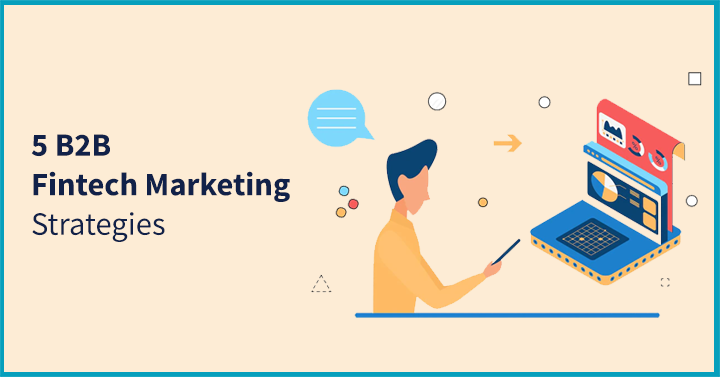
B2B marketing is different from B2C marketing when it comes to digital marketing for fintech. With B2B marketing, you target a person who needs to make decisions on behalf of the organization. Here are five B2B strategies in digital marketing for fintech that can help you effectively promote your products and services.
1. Content Marketing
Content marketing involves producing content that adds value to business customers. For example, publishing blogs, eBooks, infographics, case studies, white papers, reports, interviews, etc., are some popular methods of B2B marketing for fintech.
According to a survey, 80% of business decision-makers would gather information from online resources. Content marketing raises brand recognition and generates high ROI through engaging content and interesting touchpoints.
Chaser Technologies Limited, Green Dot, and Onfido are some B2B fintech companies doing a great job at content marketing. If your B2B firm is sales-heavy, it is better to start creating content that addresses the most pain points and answers the frequent questions.
As long as your content is helping your audience overcome financial challenges, that is enough.
2. Email Marketing
B2B consumers are more likely to be responsive to promotional emails. A weekly or bi-weekly newsletter is a great way to engage your target audience and keep them in touch with the business. You can take a step ahead by using a targeted approach for every segment.
Direct mail is an excellent B2B lead generation strategy that starts by increasing networks, reaching wider audiences, improving online visibility, and connecting with decision-makers. According to the campaign monitor, email marketing generates 3,800% ROI for a business. For every $1 spent on email marketing, the average ROI is $38.
Earlier, strategies in digital marketing for fintech companies typically were in-person trade shows and events to get leads. Today, companies can use email marketing to seamlessly position their brand as a trusted financial advisor and generate qualified leads.
3. Community Marketing
As part of digital marketing for fintech, it is probably one of the popular marketing tactics in the fintech industry. It involves creating close interactions with your target audience and applying them to develop your business. It helps in building loyalty and long-lasting relationships.
Many successful companies have taken advantage of the tactic and focused on building strong communities that drive client retention and growth. For instance, one can join open BETA groups, Live Q & A sessions, ask customers to name future products, get feedback on existing offerings, etc.
Fintech companies often find it hard to make emotional connections with their customers so digital marketing for fintech brands requires more focused strategies. Community marketing is an effective way to connect with customers and maximize on the advantages of digital marketing for fintech. One can incentivize third parties or influencers to access niche communities and spread awareness about their product or brand.
4. Experiential Marketing
Experiential marketing, also known as experience marketing, is all about physically connecting and engaging your audience by providing them with a unique experience through your brand. It is widely used in the consumer space. However, many fintech firms have successfully applied this strategy to generate buzz and boost sales.
On a mass scale, experiential marketing helps fintech firms promote and educate the target audience on concepts such as wallets, merchant loans, all-in-one POS machines, insurance offerings, QR codes, etc.
For complex products like digital payments, a mix of manual and experiential marketing practices would be ideal to boost growth in digital marketing for fintech companies. It enables your customers to not just buy your products or services, but experience your brand.
5. Partnership Marketing
Partnership marketing as a strategy in digital marketing for fintech involves collaboration with third-party brands or businesses associated with a market segment you are interested in targeting. Companies use this marketing tactic to validate and market their products pre-launch stage. According to sources, nearly 75% of banks and credit unions have entered into fintech partnerships.
Affiliate marketing and distribution partnership are the most effective methods of partnership marketing. These techniques give you access to a large audience of potential customers. One can leverage partners with existing relationships to gain access to the most likely prospects.
For instance – The US bitcoin leader Ripple used partnership marketing techniques to reach and acquire new customers. As a result, they managed to secure a partnership with some of the world’s most prominent financial technology organizations, such as American Express, MoneyGram, Bank of America.
Fintech Marketing Case Study Examples
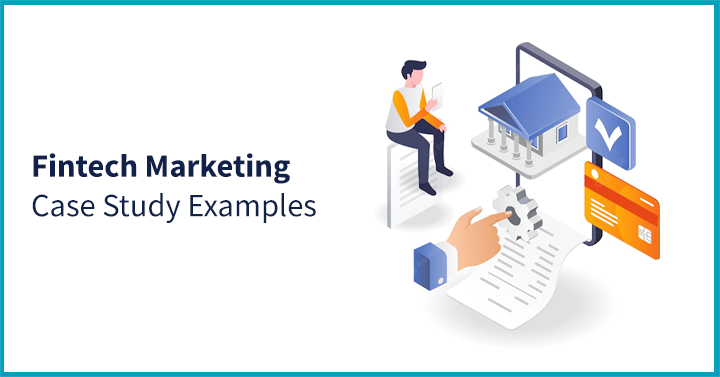
With emerging technologies setting the pace for many industries, some fintech firms have gone beyond with little creativity in digital marketing. Here are some case study examples for digital marketing for fintech companies.
1. Social Financial Inc (SoFi)
Social Financial Inc, also referred to as SoFi, was launched as a digital tool to help college students obtain more affordable loan options. In digital marketing for fintech, SoFi led its way by creating a website that acts as a resource center by offering custom calculators and valuable how-to guides.
From loan refinancing to first-time home buying – the website of SoFi offers lots of tools and tips to help people make better financial decisions. Its new campaign extended its reach beyond loan refinancing to promote itself like a full-service bank.
The best thing about its marketing strategy is the focus on aspirational messages in advertising and marketing materials. Additionally, it produces podcasts, newsletters, and blogs tailored to meet the needs of individual customers.
2. Stax (formerly FattMerchant)
FattMerchant leveraged the benefits of digital marketing for fintech to turn its website into a primary lead generation source while breaking into the merchant service industry. They integrated a strong brand personality into their website while educating their customers on social media.
As a result, they improved their lead generation 5X in 7 months with the right digital marketing strategy by optimizing their website for conversion. With industry-specific landing pages and built-in savings calculators, they would give their customers an estimate on how much they could save by switching to FattMerchant.
The keyword-optimized social media campaigns also drove visitors to premium content and generated better conversions. From lead nurturing emails to informative payment processing blogs, they adopted a rich content marketing strategy for fintech that helped develop qualified prospects.
3. Wealthsimple
WealthSimple is a Canada-based fintech company that adopted unique content marketing strategies via WealthSimple Magazine (their corporate blog) to turn customers towards cryptocurrency investment and stock trading.
From company news to financial how-tos, the magazine features diverse content that attracts people from different backgrounds and at different stages of life.
Instead of stereotypical content, the blog digs deep into how individual people manage their finances, Money Diaries, personal financial goals, aspirations, unconventional career paths, financial mistakes & regrets, and more.
Unlike other financial brands with bad gradients and electric blues, the visual appearance and content marketing assets are highly narrative and stylized. In addition, they are looking into creating podcasts to grab the audience’s attention in the near future.
Conclusion
Digital marketing for fintech can play an essential role in filling the gap left by traditional marketing. If you follow the above tips, building a successful marketing strategy for fintech is entirely within reach. Moreover, by using the above digital marketing for fintech, you can take a bigger slice of the market.
It’s also helpful to work with a partner – that’s where Growth Ganik comes in. We’ll work with you to get the most out of your fintech marketing strategy.
Ready to know more? Get in touch with us.
FAQs

What is digital fintech?
Digital fintech is a broad term that refers to the innovative use of technology and products in delivering financial services.
How do you market a fintech company?
There are several ways in digital marketing for fintech companies to grow businesses, including – SEO, social media, email marketing, video marketing, ad campaigns, etc.
Where do fintech companies advertise?
Platforms in digital marketing for fintech companies typically include Google, Facebook, Instagram, Linkedin, and YouTube.
About Us
Growth Ganik is a rapidly evolving digital marketing agency in Sydney, Australia that specializes in SEO, content marketing, marketing strategy and lead generation.
We work with clients from leading brands and industries such as B2B SaaS, nonprofits and more to develop profitable digital marketing solutions that are data-driven to support all kinds of business goals from widening user bases, gaining more traction for online engagement, to increasing conversion and helping businesses scale up.
For creative tailor-made digital solutions and sustainable growth insights, get in touch with us!

